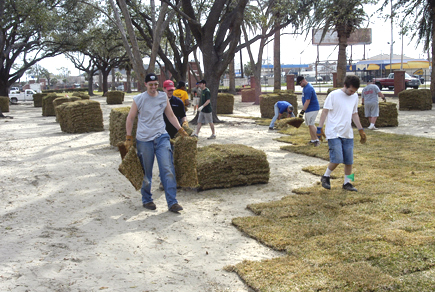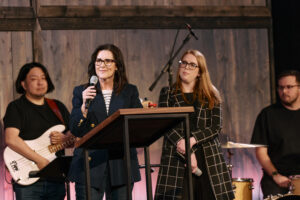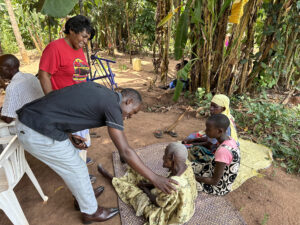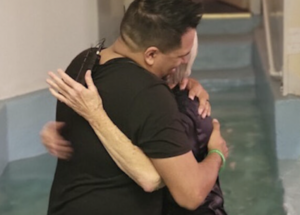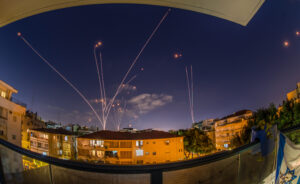
WAKE FOREST, N.C. (BP)–More than six months ago, Jim Innis stood on the campus of New Orleans Baptist Theological Seminary in the wake of Hurricane Katrina, surrounded by flooded buildings, uprooted trees and a campus that was only a shell of its former self.
Katrina had just completed its ravaging of the Gulf Coast region, leaving much of New Orleans, including much of the Southern Baptist seminary, under several feet of polluted water. How the school would rebuild and continue in the face of such colossal disaster remained, at that time, as murky as the water that was beginning to recede from its buildings.
“The only analogy I can think of is being a soldier on the battlefield, sticking your head out of a foxhole and thinking you’re all alone,” said Innis, who, as assistant director of operations for the NOBTS campus at the time, was responsible for its buildings and grounds — not an enviable task at that time, given their condition. “That’s how we felt a lot of times during those initial days.”
Fortunately for Innis and the rest of the seminary’s residents, Southern Baptist volunteer help was on the way – including three teams of students, staff and faculty from Southeastern Baptist Theological Seminary, its sister seminary in Wake Forest, N.C.
Their efforts, part of Southeastern’s disaster relief plan to aid the entire Gulf Coast region known as Operation G.R.A.C.E., were nothing short of a miracle for Innis and his staff. Combined, the teams that assisted the New Orleans seminary provided nearly $360,000 in labor costs.
“When Southeastern groups started coming in, it was almost like looking out of that foxhole and realizing that the Marines had landed, that those that God had placed in the same calling had come to your rescue,” Innis said. “It’s been probably the single most encouraging event that I’ve ever experienced in my life, knowing that students from another seminary have stepped in here out of their normal walk of life and made sacrifices, some of them great sacrifices, to be here and stand in the gap with us. It has been just unbelievably encouraging and uplifting.
“And when I stand back and watch the impact that these students have had and the dollar savings they have had, and I realize the faces that were on this campus before, and that that impact is going to mean that those people are able to get back here faster, and that hopefully there will be some reserve monies there to help them with schooling costs and things like that –- this side of heaven, nobody will ever be able to convince them or explain to them the impact they’ve had in the Kingdom of God.”
In all, 450 Southeastern students took part in four disaster relief trips, Dennis Darville, Hurricane Katrina response coordinator for Southeastern Seminary, reported.
“Operation G.R.A.C.E. was a labor of love for Southeastern Seminary,” Southeastern President Daniel Akin said. “I am so very proud of our students, staff and faculty who sacrificially gave their time, money and energy to serve others. Any blessing we were able to give to those hurting from Katrina is nothing compared to the blessing we received in ministering to them.
“The lives of those who went there were changed forever. Ministry looks different now, and it always will.”
For Darville, who organized and led all four trips, the experience of watching Southeastern students helping those in need left a lasting impact upon him.
“Southeastern Baptist Theological Seminary students represented Christ’s Kingdom in a manner worthy of His glorious name,” Darville said. “These 450 students spent four grueling weeks working from sun up to sundown, endeavoring to restore significant portions of the Mississippi and Louisiana communities damaged by the destruction of Hurricane Katrina. I was personally and profoundly moved by observing their dedication to represent the Kingdom and bring relief to the victims of this violent storm.”
Southeastern’s most recent trip, with 138 students, saved New Orleans Baptist Seminary more than $130,000, as students worked on cleaning out and painting damaged apartments, laying sod, painting metal rails and preparing a playground area for use once residents return.
But what would make these students want to give up their spring break week, typically spent at more exotic locations than formerly flooded New Orleans, in order to help other seminarians? Students like Audrey Mills, a senior at Southeastern College at Wake Forest, who could be found shoveling dirt on a playground, agreed that spring break -– and all of life for a Christian -– is about something much more than oneself.
“I’m living for more than the here and now, more than going to the beach on spring break,” Mills said. “I love work like this. I feel like it’s showing the love of Christ in a practical way. Scripture says, ‘They will know you by your love,’ and I feel like it’s a testimony to the people around you when Christians are acting like a body and a family.”
In addition to their work on the New Orleans campus, students also ventured off campus to assist local residents in gutting the ruined remains of their homes and churches.
Seminary student and Operation G.R.A.C.E. team leader Brian Whitson led a team that in a matter of days made what may be one of the most lasting impacts upon the city of New Orleans. Frustrated initially because they had been unable to find a family to help, Whitson’s group pulled into a Red Cross station, informing one of the workers there that they were looking for someone to assist. Little did they realize the providential appointment that conversation turned out to be.
“We’re here to help people, to minister to people, and we can’t find anyone to help,” Whitson recalls telling the woman. “And she said, ‘My brother is a pastor and his church needs help.’ So we said, ‘Take us there.’”
“There” ended up being a local Baptist church, St. Peter’s Baptist, located in New Orleans’ hard-hit Ninth Ward area and once an evangelical light in the community, operating a food kitchen to feed the homeless. Katrina’s waters had flooded the three-story church building, sending three and a half feet of water into its fellowship hall. Since few of the church’s members were still in New Orleans and it was in no condition to reopen its doors, its pastor, Alex Robertson, was forced to find work washing cups and dishes at a local warehouse seven days a week to support his family.
Robertson was committed to seeing his church reopen again –- in fact, he chose to put his FEMA trailer next to the church for that purpose -– but he lacked the time, money and supplies to make it happen.
Then along came Whitson’s group of Southeastern students, who bleached, scoured and re-tiled the interior of the church, bringing it up to operational condition within a matter of days. However, having exhausted their budget, the team realized they had not yet been able to replace all of the kitchen cabinetry that would enable the church’s homeless ministry to continue.
Unwilling to be deterred, team members contributed some of their own money and called their local churches for pledges of support, raising in a matter of 30 minutes $1,000 to restore the church kitchen, which they then proceeded to do.
Akin said Southeastern’s commitment to continue “doing something” for Katrina victims through Operation G.R.A.C.E. will not end with the current school year. Instead, Southeastern will be involved as long as it takes, and Darville will continue to coordinate trips with local churches.
“Our future plans are to seek to partner with local churches in the area through NAMB’s Adopt-a-Church program,” Akin said. “We will stay involved for several more years until the Lord says stop. The need is still there. We will continue to go.”
–30–
